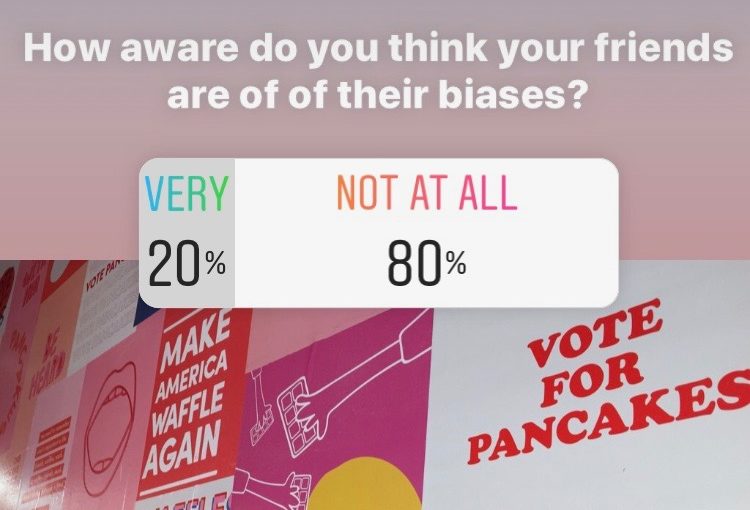Recognizing Our Own Cognitive Biases as Content Creators
Note: In this post I mention the phenomenon of “fake news”. Please note that this is to give contextual reference to ideas in this post, and I apologize beforehand to those of you who feel as thoroughly sick of the phrase “fake news” as I do.

As a community, whether we wanted to or not, we were recently brought face to face with news about ourselves we didn’t want to hear (and may still deny). We are inherently biased in our viewpoints and opinions.
For some people this is not a shocker. For most of us, the fake news phenomenon that hit rock bottom with the recent presidential election was a wake-up call whether we wanted it or not. It was a moment to look in our social media mirror and see writing on that mirror that pointed out the flaws in our reflection. (So very meta!)

I use this metaphor to say that the content we chose to consume, on whatever internet channel we frequented, was implicitly biased to match our own viewpoints, and we were forced to recognize this. (Which totally sucked. #amiright?)
We are biased in the content we consume. How biased are we in the content we create?
As we are so biased in the content we consume, how biased then are we in the content we create? And how do we combat that bias or at least become aware of it in our work?
Assumptions We Make Personally
I have always been aware of the concept of bias. Growing up in a household governed by strong and divergent views of our reality, this was readily apparent to me, and as a fairly judgmental teenager it was easy for me to see the biases of the authors I read, the teachers I listened to, and the views of the people around me.*
This led me to a deep skepticism of journalism. Not journalism in and of itself, which is incredibly detail oriented and well meaning, but of the belief that true journalism is unbiased and objective. This struck me as ludicrous. Anything a human individual writes is biased; therefore, anything we write as content creators will reflect our own personal biases, whether intentional or not.
Entering the world of content creation, I assumed that others had this same viewpoint. It was no challenge for me then to become a content creator for a brand/company/institution, since I assumed that my readers would be as educated as I was and be able to discern somewhat the biases inherent in the content I wrote.
The recent, unfortunate, phenomenon summed up by the phrase “fake news” reminded me that many, many people do not have the education or privileges of my own background, and that prodded me to be more aware of my own biases. Imagine how fascinated I was then to discover that there are multiple defined types of bias, called more specifically cognitive biases.^
Cognitive Bias: The Types of Bias & How They Work

There are, apparently, over 200 varieties of cognitive bias! Can you believe that? Here are three prevalent types of cognitive bias:
- Optimism bias: A bias that causes someone to believe that they themselves are less likely to experience a negative event (also known as unrealistic or comparative optimism).**
- Confirmation bias: The tendency to search for, interpret, favor, and recall information in a way that confirms one’s preexisting beliefs or hypotheses (also called confirmatory bias or myside bias).
- Normalcy bias: A bias that causes people to underestimate both the likelihood of a disaster and its possible effects, because people believe that things will always function the way things normally have functioned (or normality bias).
Our Biases as Content Creators
In the ‘verse of content, those three biases might be defined something like this:
- Optimism bias: Creating content, any content, will surely be good because content marketing is a cure all (and my client wants it), or maybe, we have a content strategy and while it might not be documented or well defined, it’s probably effective.
- Confirmation bias: The content we are creating is valuable to my company, brand, industry, or subject matter experts; therefore, it will be valuable to my audience. The way we approach our content from a company viewpoint is the same way our audience approaches it.
- Normalcy bias: The type of content I am creating has proven valuable in the past, therefore producing more content structured in the same way will continue to achieve the desired results.
Content biases can range from our beliefs about how our content strategy is working (optimism bias) to the format in which we structure our content (normalcy bias).
I looked at some of my own work through the lenses of these biases, and here are some things I discovered.
Optimism Bias
In our organization, we produce, on average, 65 pieces of content per month. This includes the following:
- Evergreen webpages
- Press releases
- Blogs
- Podcasts (which become webpages when transcripts are posted)
- Article/feature style pieces
- Videos
- Infographics
- Print pieces
I have been more studiously auditing our organization’s web content assets (4K+ specific to content marketing and roughly 30K+ to evergreen web pages). At a certain point, you have to ask yourself if this is sustainable. While we work to abide by best practices, I sometimes wonder how effectively we are abiding by those practices and what assumptions we are making about the success of our various content formats.
We also have multiple content creators spread across multiple teams. The standards they employ and consider normal and not always what I think of first as normal! My content is always biased towards either tracing the efficacy of content towards ROI, meaning I write and maintain a lot of content targeted to potential patients or students.
The best practices that work for the content I create do not apply to content created by other teams. My sphere of normalcy is not the same others’. This is a bias that I try to be aware of when I’m working with other content creators. But boy is it hard!!
The best practices I apply to the type of content I create don’t necessarily apply to content created by others. While we start with standard practices, we don’t necessarily end up there.
As Robert Rose recently said in a webinar I watched (through the Content Marketing Institute), while we start with standard practices, we don’t necessarily end up there. And what’s normal for us may not work for all of our stakeholders. It’s a good thing to remember.
Confirmation Bias
A good example of confirmation bias in my work is a written piece we created for our joint replacement services. Our ortho services identified this specialty as a priority, so we determined to write something targeted to potential patients to help them decide if it was the right time to get a joint replacement.
We initially assumed that patients would approach this job, of finding information about a hip or knee replacement, in the same way that our specialists (and we!) think of it as: “When to Get a Joint Replacement”. (Can you already see the problem here?)
Fully expecting the piece to have a good traffic footprint, we pulled data for the page after six months. We were shocked to discover that it was performing abysmally! A little keyword research analysis later, and it was clear why that was happening.
People looking for information about hip and knee replacement don’t think of it as joint replacement. We separated the content out into two different pieces: “When to Get a Hip Replacement” and “When to Get A Knee Replacement”. Traffic improved 450 percent comparatively—I kid you not.
Just because we are used to regarding a content topic from a certain viewpoint—involving jargon or with an industry-focused approach—doesn’t mean our users do. A lesson we technically are intensely familiar with, and yet we still create, on occasion, a piece that is biased towards our industry and not our user.
This was a good reminder to focus time and effort around identifying not just what may help our potential audience but also to explore their approach to it and not our own.
Normalcy Bias
A few years ago, I wrote a piece about the symptoms of heart disease called “When to See a Cardiologist”. It was structured as a listicle, as that was (and still remains I believe?) a popular format to consume content.
Within a few months it became the most visited page within this subsite and even translated to clicks on the associated call to action “Schedule an Appointment.” This was undoubtedly a success, and one that we use frequently as an example for our clients of what specifically targeted content can do for our audience.
Imagine my surprise then to discover a few months ago that traffic to this piece had dropped by 25 percent! Not gonna’ lie—I experienced some panic. My team and I started to look into when and how this had occurred. We couldn’t necessarily pinpoint the exact cause, but did connect a few dots.
With the introduction of the Google answer box, which wasn’t necessarily that recent, this piece of content showed in search results in a different format to users. While best practice dictates that the heights of achievement are unlocked when your content shows in an answer box, the way our piece showed now could be considered detrimental to us, if our success measure was solely to drive traffic to our website.

I don’t know about you, but looking at that result (Fig. 3) as a user, I’m suddenly much more confident in making a decision about whether this content will help me find what I want to know. It’s also easy to assume that the 10-item list may not be detailed enough information for me.
In the future, I will be doing more research on whether a list format is the approach I want to take when creating a content piece of this type.
Content Bias in the Process of Content Creation
I hope my examples of content matching the specific cognitive biases of optimism, confirmation, and normalcy have given you some ideas of your own regarding bias. While the fake news travesty continues to make my own biased viewpoints resonate in frustration, I am making an effort to think about issues from other points of view. It sure ain’t easy!
Also, I plan on exploring more information regarding the types of cognitive bias. Understanding the biases of our audiences obviously is essential for us as content creators. It’s also important that we separate the inherent biases of our organizational need vs. our user need. I really can’t emphasize that enough. While we may think we are aware of that bias—believe me—we aren’t completely aware.
What biases can you find in your industry and more specifically your company? How do you approach them when you create content? It’s a question we are all going to have to be more honest about on reflection if we want to be successful in connecting with not just our users, but ourselves as well.
*Naturally, as a judgmental teenager and later college student, I was less aware of my own personal biases.
^While watching some continuing education videos for my project management professional certification, I listened to a fantastic presentation by Mario Alt titled “The Mission Critical Project Manager” that discussed cognitive bias.
**Wikipedia

